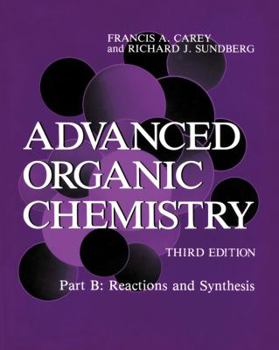Advanced Organic Chemistry, Fourth Edition - Part B: Reaction and Synthesis (Advanced Organic Chemistry / Advanced Organic Chemistry)
Select Format
Select Condition 
Book Overview
Since its original appearance in 1977, Advanced Organic Chemistry has maintained its place as the premier textbook in the field, offering broad coverage of the structure, reactivity and synthesis of... This description may be from another edition of this product.
Format:Paperback
Language:English
ISBN:0306434571
ISBN13:9780306434570
Release Date:January 1990
Publisher:Kluwer Academic Publishers
Length:2 Pages
Weight:3.84 lbs.
Dimensions:1.8" x 7.1" x 10.0"
Customer Reviews
4 ratings
Amazing reference
Published by Thriftbooks.com User , 17 years ago
This book is not for introductory organic students. It is a condensed review with some explanation for a huge number of synthetically useful organic reactions. It explains exactly what it needs to, with diagrams when necessary. This book has been extremely useful in my graduate level organic classes.
Really good books
Published by Thriftbooks.com User , 18 years ago
Both A and B part are very good reference book for organic chemistry graduate student. It is worth to have one if you want to open your career in organic chemistry
Course on Organic Synthesis
Published by Thriftbooks.com User , 23 years ago
Carey and Sundberg had written the most detailed and briliant account in the subject of organic chemistry. This volume along with Part A (Structure and Mechanisms) contribute to the most updated account in advanced organic chemistry. Part B deals with organic reactions with emphasis on stereochemical consequences. Discussion focuses on the most important reactions and methods in modern organic synthesis.Alkylation of nucleophilic carbon intermediates discuss regioselectivity and stereoselectivity in enolate formation. The coverage on enolate alkylation is excellent that emphasizes on the model that predicts the stereochemistry of alkylation. The discussion also introduces Ireland model and Zimmerman-Traxler model. Reaction of carbon nucleophiles with carbonyl groups focuses on some of the most significant reactions: Mannich reaction, mixed aldol reaction, Wittig reaction and the Horner-Wadsworth-Emmon reaction. The discussion again focuses on control of regiochemistry and stereochemistry of the condensation via the use of chair transition states.The best sections in this Part B volume of the book is the complete detailed discussion on reduction and oxidation, Reduction reagents and methods introduced include hydrogenation, hydride donors, stereoselective hydride reduction, various dissolving metal reductions. Oxidation chapter summerizes all important methods like transition-metal oxidant, Collins reagents, epoxidation, peroxidic reagents, ozonolysis, and selective oxidation of certain functional groups. The revised Part B edition also includes full discussion on reactions involving transition metals and organoboron, organosilicon, and organotin compounds. This includes some of the most updated and current research topics. Other topics covered include reaction of reactive intermediates like carbocations, carbenes, and radicals. Finally, a chapter is devoted to the cycloadditions, unimolecular rearrangements, and thermal eliminations. The last chapter deals with planning multi-step organic synthesis with an emphasis on retrosynthetic analysis. This book has made organic synthesis approachable and easier to comprehend.
Magnificient in its own essence
Published by Thriftbooks.com User , 23 years ago
I found this book extremely easy to read and makes a great addition to the library owned by an organic chemist. Certainly, this book deserves much attention and I believe that it describes many concepts in a simpler manner when comparison to Jerry March's book is called upon. The book is well-written and is exactly what undergraduate students interested in organic chemistry need to read if they want to expand their knowledge of the field without getting into a complex text right away. Definitively, I recommend this book in the shelf of any practicing and non-practicing chemist.





